by Marion Patterson | Apr 13, 2023 | Amphibians/Reptiles, Birds, Flowers/Grasses, Hearing, Nature, Wonderment
A Season of Variables
After a drab March “look up, look down, listen” season is here. It’s exciting and frustrating. Always something to see and hear and things we miss, too.
What is look up, look down, listen? Well, when we walk in woods and prairies, we’re always attuned to nature’s beauty and curiosities. In the Northern Hemisphere April and May force challenges and delights, as the earth turns toward the sun. Its warmth stimulates new life while welcoming arrivals from down south.
Here in Iowa, like much of the United States, bird migration rises through April and peaks in early May. Woods, wetlands, and prairies are filled with bird species we haven’t seen since last year.
Look Up!
“Look up,” Marion remarked on one April walk last year. She spotted the first Rose Breasted Grosbeak of the season. He was perched on a thin branch high in a sycamore tree. As we walked along, we kept looking up to spot other new arrivals. They added color and song to those of cardinals, chickadees, and woodpeckers who are our neighbors all year.
-
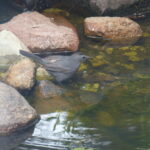
-
A catbird drinks by a pool.
-
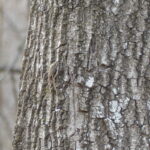
-
The brown creeper blends in with tree trunks.
Look Down!
After admiring the Grosbeak and moving on, I said, “look down.” We had been paying so much attention to birds up in the trees that we almost trampled a Dutchman’s Breeches, a delicate white wildflower with petals shaped like old-time Dutch pants. Looking down revealed spring beauties, Mayapples, hepatica, and anemones. Some were not quite in bloom and a few had gone by, but most were in their spring glory.
-
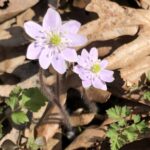
-
Early spring flowers
-
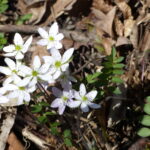
-
Reaching for the sun
-
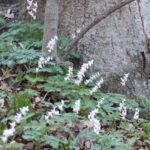
-
Dutchman’s Britches
-
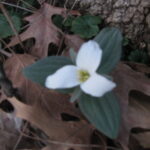
-
Snow Trillium
Shhhh! Listen
Passing a low wetland, we both paused to hear the songs of the chorus frogs and peepers that greet listeners each spring between the vernal equinox and Easter.
So, what do we do on a spring walk? Look up or down or listen? All of these. It is the best time of year to enjoy beauty clinging to the soil, singing from treetops, and chorusing from ephemeral pools.
Make Nature ID easier with Apps
Spotting birds hiding invisibly in tangles of branches and vines is challenging. What’s in that thicket singing? Thanks to the Cornell Laboratory of Ornithology, we turn on our Merlin app, point the phone where the songs originate, and learn who’s singing. Merlin is easy to download from the app store. Sometimes we are lucky and watch migratory birds close at hand.
Some people even lure birds in with treats that are eagerly consumed by arriving birds.
Wildflowers cannot hide but can be confusing. We sometimes use an app called SEEK to identify ones that are mysterious to us. SEEK is also easy to download from the app store and can also help identify trees, weeds, and other living things.
Look up, look down, listen! season may be the very best time to be outside. We love it.
by Winding Pathways | Aug 19, 2021 | (Sub)Urban Homesteading, Amphibians/Reptiles, Garden/Yard
Outside our dining room is a tiny pond crafted by our home’s previous owner. It’s smaller than a compact car and is the regular home of water lilies, dragonflies, and a few goldfish we stock to eat mosquito larvae. One morning we were astonished to spot a large frog partly submerged on the pond’s edge. Where did it come from and how did it get here?
We live on an ancient sand dune. Rain quickly percolates downward, so the rubber membrane at the pond’s bottom holds water that would otherwise quickly disappear. No other bodies of water are close by. Could our frog have hopped a half-mile uphill from Indian Creek? Did it come from a nearby neighbor’s pond? And, how would it have got there since we all live on a hill?
We know birds, insects and mammals find and settle in new habitats. They’re mobile and fly or walk until they spot a new home place. Frogs and turtles can walk – or hop -but they’re slow and vulnerable to predators when venturing on land.
Ask the Expert!
We didn’t know how our frog found our pond, so we asked biologist Dr. Neil Bernstein.
He responded by saying that some frogs disperse from wetland to wetland randomly, and there’s speculation that eggs can attach to waterfowl legs. His short answer was, “I don’t know”.
That’s a wise response. Science has revealed many of nature’s mysteries, but more remain unknown. Did our frog somehow sense that a tiny pond way up yonder would be a good place to risk hopping to? We don’t know but we’re certain this wandering amphibian is welcome to enjoy life at Winding Pathways.
-
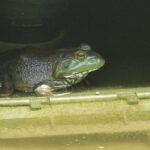
-
Waiting for lunch in the shade.
-
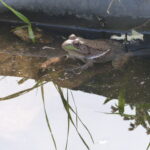
-
How the frog came here is a mystery.
-
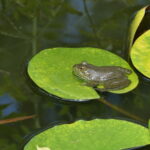
-
Resting in the sun.
-

-
Leland, Mississippi is home of Kermit the Frog.
by Winding Pathways | Jun 24, 2021 | (Sub)Urban Homesteading, Amphibians/Reptiles, Garden/Yard, Nature
Guest Blog by Leslie Wright
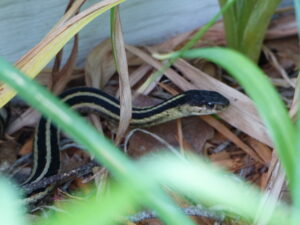
Garter snakes like cool, shady places to wait for a meal.
Just over a year and a half ago, we moved from a home with a suburban postage-stamp-sized yard with little wildlife into a home with a large yard that backs up to a sizable park. Each season we have discovered something new about our new urban “wilderness”. Last spring it was how to identify (and avoid) poison ivy. This spring the theme seems to be reptiles! Earlier this spring I became acquainted with our resident garter snake. Most often it spent time in our vegetable garden but occasionally sunned itself near where I was working in the yard. Though I am not comfortable around snakes I was glad to see him/her – to me a symbol of more abundant life.
How the Adventure Began
Thursday, May 6th seemed like any other lovely spring day. I took myself outside to walk around the gardens and see what was coming up. I walked around to the front of the house to check on hydrangeas I had planted last spring. I had wrapped them in bird netting last year thinking to keep deer from nibbling the tender shoots. To my dismay, I discovered that our resident garter snake had become entangled in the netting, and even worse a much larger snake had also found its way into netting nearby. To my uneducated eyes, this snake looked like a small rattlesnake with a brownish diamond pattern. I was almost relieved that it appeared to be dead. But I knew I needed to rescue my garter snake friend. I was afraid to do this myself – afraid of getting bitten mostly.
So, I started to call and text everyone I could think of to rescue this snake – and me! My husband who was in a meeting, the nature center, DNR. But, alas, I soon figured out I was going to have to tackle this myself if I wanted the snake to survive. So off to Google I went.
Google To The Rescue!
The snakes had netting in their mouths and wrapped around their bodies, multiple times. Google informed me I would need to gently restrain the snake and use nail scissors to cut it free. So, I put on gardening gloves, found a stick with a small fork to hold the snake’s head, and armed myself with nail scissors. Probably more to calm myself, I talked to my little friend while I cut away the netting. Success! After I freed the garter snake I went inside for a moment.
-
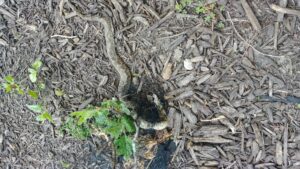
-
Netting gets caught in the snake’s scales when it tries to back out of the netting.
-
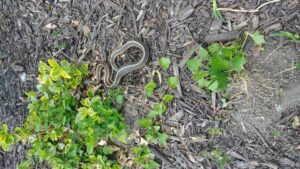
-
This snake slithered off when freed.
Rounds Two and Three
When I came back out – no lie – he/she had found its way into another piece of netting. So, round two – gloves, stick, and scissors. It was clear I needed to remove every shred of that darn bird netting to make sure it would not harm any other creatures. As I was clearing away the netting, I discovered the second snake was in fact alive. Now I had to save it, too! So round three – gloves, stick, and scissors, and the second snake was free. I later learned this is a fox snake.
All Is Well That Ends Well
I haven’t seen them since but I surely hope they are safe, well, and still visiting our yard.
by Winding Pathways | May 27, 2021 | Amphibians/Reptiles
Starting about mid-May when days and evenings began to warm up we’d hear off tune, extended croaking in damp spots around the yard, high in the trees, tucked into the woodpile and even on the side of the house. A few days later, high-pitched off-key trills burst from the little pond outside our bedroom window. It’s spring in Iowa and the tree frogs and toads are loving the moisture and warmth as they initiate their spring serenade.
Hyla Versicolor, or eastern Grey Treefrog, are fascinating amphibians. These diminutive creatures – about 2 and a half incles long – can change their rough, mottled skin within moments to better blend into their environment. Their large toe pads help them climb most surfaces, including buildings. Although they prefer woods’ edges, they also are found clinging to houses and even light posts! Once we spotted one clinging to our window. After mating, they tend to wander off into the forests to feed.
In winter they shelter under tree bark or leaves. A fabulous adaptation of changing glycerin to glucose that circulates through their organs prevents ice crystals from forming. Although remaining water freezes, they do not die. Come spring they thaw out to serenade us again.
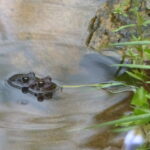
Toads need water to mate.
The other night caller is the American Toad. Come dusk through the wee night hours, they sing merrily and mightily. They wander to the water to mate and reproduce, then they hop off to eat insects. They are especially helpful in gardens. Some of our friends even make toad habitats for them! Two protections protect these slow moving amphibians. A gland near their eyes secrets a nasty liquid that repels predators. This gland does NOT cause warts. That is just a silly story people tell kids for some reason. And they pee. When picking them up grasp them gently around the middle and hold them away from your body so you don’t get sprayed. Toadlets hatch by the hundreds a few weeks into summer and somehow make their way to safety. We hope you enjoy these late spring singers.
by Winding Pathways | May 28, 2020 | (Sub)Urban Homesteading, Amphibians/Reptiles, Garden/Yard
For many years Rich wrote a nature column for the Cedar Rapids GAZETTE about little known aspects of natural history common in suburbia. He was amazed when more people responded to a column on toads than anything else he had written. People like toads. Some readers called him to talk about “their” toad that lives in the garden or a damp corner in the garage. They wondered what treats they could give “their” toad.
Toads Range Far and Wide
Toads herald spring’s arrival with lusty evening trilling, usually in May. Common and intriguing, they enjoy living in suburban yards as well as woodlands and wetlands.
Many toad species inhabit the world but the Eastern Toad is most common in the United States. It ranges from about Nebraska east to the Atlantic and from southern states north to nearly Hudson’s Bay in Canada.
Where do Toads Live?
Both toads and frogs are amphibians. (The bloopers at the end of this video are fun to watch! Shows what it takes to put together even one short educational video!)
Toads, however, spend much of their lives away from water. A damp shady place to live and plenty of insects and other invertebrates to eat suits their needs. Toads often spend the day hiding in damp garages, under rotting logs, and in secluded garden spots. Come evening they hop around seeking tasty bug meals.
As amphibians toads need standing water to reproduce. Each spring toads hop to ponds, wet road ditches, and big puddles to serenade the night with their loud trilling. Females lay two strings of eggs in the water that hatch into tadpoles within two weeks. The warmer the weather the faster the eggs hatch. Toad tadpoles are easy to recognize. They are tiny, black, and have bodies much larger than their thin tail. Often hundreds swarm in a small pool. In less than two months they change into mini toads that hop far and wide seeking a place to live. They’ll eventually grow to about three inches long.
-

-
Toads sing loudly day and night.
-
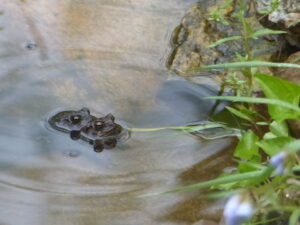
-
Toads need water to mate.
Who Eats Toads?
Although many animals enjoy a frog meal, few eat toads. When bothered toads often emit a foul-tasting liquid that makes a hungry dog or raccoon immediately drop the animal unhurt. Probably their main predator is the hognose snake, which relishes a toad meal.
Caring for “Your” Toad
Most people like toads and many gardeners create damp quiet places in their gardens for them to take shelter during the day and forage for pesky insects come nightfall. As for a toad treat, well, they really don’t need one but they might like to snack on a few mealworms or earthworms.
#
by Winding Pathways | Jul 2, 2017 | Amphibians/Reptiles, Nature
Our blog on snakes in the yard struck a note! People loved it and some shared their “rattler” experiences. But, for most of us, snakes are helpful in the yard and we can help them, too, as these readers did. From Jackie and Peter Hull in Bedford, Virginia, a story about how they rescued a black snake.
“Several years back to protect my strawberries from birds we tucked some netting around the raised bed of strawberries which seemed like a good idea at the time. It allowed the bees and butterflies to pollinate the blossoms, but kept out critters or so we thought. One morning I was out strolling through the raised beds noting what was coming along. Much to my dismay I spotted a huge shiny black snake had become entangled in the netting. It was trying to retreat or move forward but every move just made his situation worse.
“A black snake is a godsend to gardeners and their gardens, so to have this garden friend tangled and suffering was not so good. I scurried to the house letting my husband and tough ex-Marine, Peter, know that I needed his help in the garden immediately because a black snake was in distress. I grabbed some scissors while Peter put on a long sleeved shirt, pants and leather gloves. We met by the strawberries. Peter was not in the least bit interested in untangling this creature, but I was. So I began snipping the plastic strands from around the snake’s body. Snip by snip I finally released the snake who had spent a very long time struggling to become free. He didn’t make an aggressive move so we picked him up and put him across the lane near the shrubs.
“This scenario repeated itself the following year until an idea formulated in my head. I thought: “Let’s build a screen like a window screen and place it on top of the raised bed.” We measured and ruminated about the size since we needed it to be tall enough for the plants to grow their berries. This was a complete success as the following spring we attached this contraption to the top. The bees and butterflies were able to do their work, but the birds, mice and black snake never could get in.
“The black snake is still around but not in the strawberries. Peter said he saw him a few weeks back slithering up the gravel driveway. I’m just glad he doesn’t get tangled in netting anymore.”
















